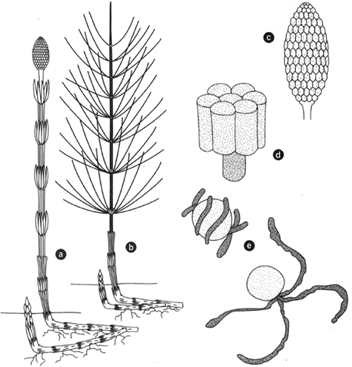Horsetails
Horsetails were large marks on the landscape in the latter part of the Paleozoic era, more than 300 million years ago. Then, they were like big trees, reaching heights of 100 feet. Now, they are but remnants of their former selves, limited in height to several inches. The sole exception is found in tropical America; Equisetum gigantium has a weak, waxy stalk that can reach a height of 30 feet.Equisetum arvense serves as a good example of horsetails. It produces both vegetative and sporogenous shoots. The stems are ribbed and hollow. A cross-sectional view shows three kinds of canals. The central canal
 |
| Figure 25.4 Equisetum arvertse, a horsetail. (a) A reproductive shoot bearinga strobilus at the tip. (b) A vegetative shoot. The shoots arise from horizontal rhizomes. (c) An enlarge ment of the strobilus. (d) A sporangiophore bearing six sporangia. (e) Spores, one with elaters coiled about the spore, and the other with elaters extended. |
is called the pith canal because when first formed, it is filled with pith, which in maturity breaks down to leave an open canal. The two other kinds of canals are the vallecular canals and the carinal canals. A vallecula is a groove, and the vallecular canals are aligned with the grooves of the stem. A carina is a ridge, and the smaller, carinal canals are aligned with the ridges of the stem.
At the tip of the spore-producing shoot, a strobilus develops where the sporangia occur. Upon maturity, the sporangia release spores entwined with elaters. In drying, the elaters uncoil as the humidity changes and thus aid in the dispersal of the spores. Spores germinate within several hours to produce minute gametophytes, which look like protonemata at first. The antheridia produce multiciliated sperm cells. The female gametophytes produce archegonia with egg cells unless conditions are impoverished, in which case they undergo sex reversal and produce antheridia. When fertilization occurs, a new sporophyte is produced.




